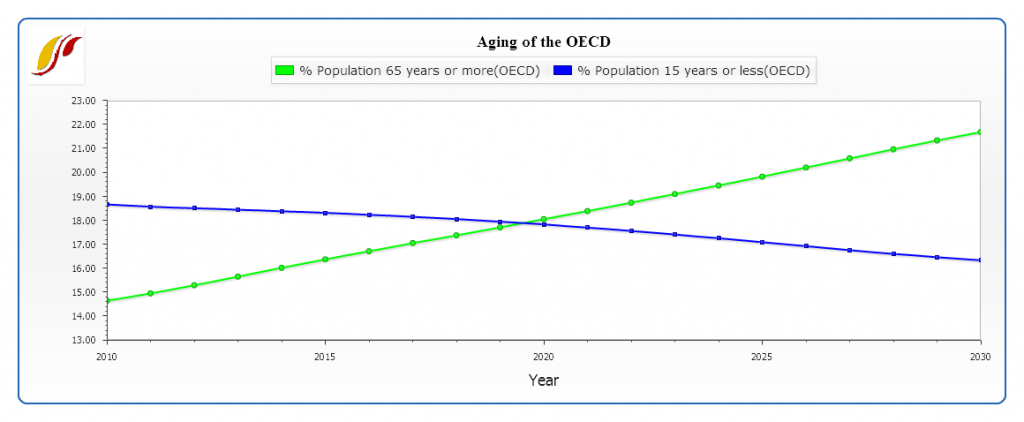Last month, the National Intelligence Council (NIC) unveiled its Global Trends 2030: Alternative Worlds report at a conference convened by the Atlantic Council. Previous reports sought to envision the world in 2025, 2020, 2015, and 2010.
Every Global Trends report challenges a new or returning US president to think about how the megatrends shaping our future will play out in different global contexts. They contain no policy recommendations, leaving it to readers to identify the trends most relevant to their future and explore policy options. But the task is daunting. The megatrends discussed in the Global Trends 2030 could have truly world-altering impact, with complex ripple effects extending to nearly every aspect of society. Understanding them will require a global effort of unprecedented scope.
The trend of global aging illustrates the difficulties involved in understanding the magnitude of such potential shifts. Demographically, there has never been a world like the one we will likely meet in 2030. The United Nations Population Fund estimates that world median age increased from 24 to 28 since 1950; by 2050, forecasts show an increase by another 10 years. Two billion people will be over the age of 60, and the developed world will be the first to demonstrate the effects. [Figure 1]
Adequately exploring this kind of all-encompassing megatrend requires a set of analytical tools for thinking about the many linkages between global health, economics, socio-political dynamics, and more. The International Futures model (IFs), developed by the Frederick S. Pardee Center for International Futures and used in Global Trends 2030, is one such tool. IFs is uniquely interdisciplinary; it integrates thousands of data series on health, economics, education, and more into an endogenous system of interaction, grounded in decades of development research. Broadly speaking, changes in country demographic structures are driven by fertility rates, mortality rates, and migration patterns. Recognizing that these rates and patterns are not static, the IFs model incorporates projected changes in factors like life expectancy, average GDP per capita, female education, technological advance, contraception use, and others into its forecasts and connects them to a nation’s future fertility and mortality rates based on historical patterns. Migration rates, the final critical component, are incorporated into the model using assumptions from the UN Population Division.
This multifactor analysis produces a simple story: An average nation making minimal advances in per capita income and health will tend to experience progressively smaller cohorts of younger citizens. For nations that already have low fertility rates, the effect becomes even more pronounced.
Germany is broadly reflective of European peers but is notable for the large size of its age cohorts entering retirement in 2030. [Figure 2] East Asia, a region of vastly greater population and even more economic clout, will follow close behind, as the effects of Japan’s and South Korea’s Europe-style aging and China’s one-child policy push its population into disproportionate old age. [Figure 3] The situation is exacerbated by low immigration rates in many of the hardest-hit countries. In contrast, regions whose populations are comparatively young will be able to exploit a “demographic dividend” as its populations enter working age. Africa in particular may hope to benefit from such a dividend perhaps as far out as 2050.
Global aging of this kind has no precedent, and so nations hoping to cope long-term with their demographic realities must think creatively about their own local contexts and how aging might impact them. Again, exploring linkages through modeling can be a crucial source of insight. IFs forecasts show a clear strain on public finances in European economies with strong social safety nets, driven by older populations being supported by a smaller workforce. [Figure 4]
Inevitably, however, some of the greatest impacts of global aging will be in the murkier arenas of politics and security. In South Korea, observers have suggested that the aging of the population has contributed to more conservative election outcomes and will continue to strengthen conservative candidates. In multiethnic Western nations, the traditionally higher birthrates of minorities will alter socio-political dynamics, while more homogenous nations like Japan (already one of the oldest populations in the world) will be increasingly pressured to alter their immigration policies. In cities, which tend to be demographically older and are set to grow dramatically over the next several decades, new challenges of infrastructure planning and social service structure will be raised. Scenario-building can help to identify unforseen effects and explore the potential outcomes of policy choices.
Like all the megatrends identified in Global Trends 2030, the interlinked effects of demographic change demand an integrated, comprehensive approach for understanding. Global trends research – and the forecast modeling on which it is based – is the bedrock of that approach and a key tool for illuminating potential futures. If we use that tool effectively, we can begin a world-wide conversation about the future toward which we seem to be heading and the futures we might prefer to shape.
Hanna Camp is a research assistant with the Pardee Center for International Futures and a former intern with the Strategic Foresight Initiative. To explore more forecasts and learn how to create your own scenarios, you can visit the Pardee Center’s homepage to download the free, open-source IFs model.






